‘God’s Battle’: O’Duffy’s Irish Brigade in the Spanish Civil War
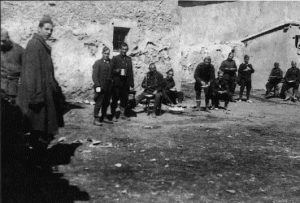
The Irish unit that fought for Franco in 1936-37. By John Dorney
In late 1936, a young unemployed Dubliner, Seamus MacKee, was told that ‘General [Eoin] O’Duffy was looking for volunteers to go to Spain to fight for the Catholic faith against the Reds who were murdering priests and raping nuns left and right all over the place’.
Perhaps out of religious zeal, or maybe due to boredom (he was, he said ‘in a reckless mood’) he decided to investigate. After contacting some Catholic activists on Dublin’s Pearse Street, he was put in a car and driven across the country to Galway. There he found several hundred other volunteers from around the country. At the city’s docks, they boarded a tug boat ,the Dun Aengus, singing the Catholic anthem ‘Faith of Our Fathers’ and sailed out into Galway bay.
About 700 Irish volunteers fought on the side of Franco during the Spanish Civil War.
At sea, the volunteers were picked up by a German ship, flying the Nazi swastika and shipped over to fight in the civil war in Spain.
At Salamanca they met their leader Eoin O’Duffy, who paraded them with the ‘Franco flag’, the Nazi banner, the Italian fascist flag and the Irish tricolour.[1]
Today, the involvement of hundreds of Irish volunteers fighting for Franco – the dictator of Spain from his victory in the civil war in 1939 until his death in 1975 – and apparently on the side of fascism, tends to be the cause of much embarrassment in Ireland. Greater attention is paid to the considerably smaller number of left wing or republican Volunteers who fought on the other side.
At the time, however, it was the right wing cause which was more popular in Ireland, perceived in many quarters as a ‘crusade’ against communism and for the Catholic religion. While about 700 Irishmen went to fight for Franco, a small number – about 200 – associated with left wing politics, the Communist Party and the IRA went to fight for the Spanish Republic.
This article does not seek to rehabilitate the cause of Irish Brigade, officially the Tercio de la Bandera, but rather to set out their experiences in the true complexity of their own time, both in Ireland and in Spain.
The Spanish Civil War
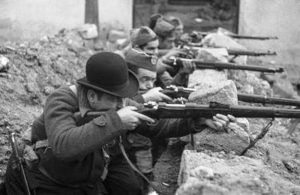
The Spanish monarchy was peacefully overthrown in 1931 and a Republic declared. The Republic, the second in Spanish history, came after seven years of military dictatorship by Miguel Primo de Rivera, but the country’s experiment in democracy proved to be short-lived.
Intense class conflict, political polarisation between left and right and between religious and secular and conflict between the central government and regional nationalists meant that the consensus necessary for peaceful parliamentary rule did not exist.
In 1934, a workers’ uprising in the northern province of Asturias, against the election of a rightist government, was brutally put down by troops under Francisco Franco. In the same year the region of Catalonia also declared independence, before that too was suppressed.
In 1936 the left wing parties, including republicans, socialists, communists and regional nationalists put aside their differences to form a coalition, the Popular Front and won the election of February 1936. The experiment in left wing rule lasted less than six months, however.
The Spanish Civil War broke out in July 1937 when elements of the Spanish military launched an uprising against the left wing Popular Front government.
In July of that year, a right wing section of the Spanish Army mounted a coup d’etat against the Popular Front government which, so the rebels alleged, could not contain rising levels of political violence, strikes, land occupations and the breakup of the country.
The military rebels under Francisco Franco[*] immediately seized parts of the north, west and south of Spain but their uprising met fierce armed resistance by republicans, anarchists, socialist and communists, as well as Basque and Catalan nationalists and loyal parts of the police and military. The capital Madrid and the second city, Barcelona, were held for the Republican government.
Instead of a rapid seizure of power by the right wing, Spain was plunged into a cruel three year civil war. It quickly became clear that Franco’s forces intended not only to topple the Popular Front government but to replace the Republic itself with an authoritarian state.
The war became an international battleground between ideologies of left and right, depicted on one side as a war for democracy against fascism and on the other for ‘western civilisation’ against communism.
Nazi Germany and fascist Italy backed the right wing or ‘Nationalist’ side under Franco, while the Soviet Union and the communist movement backed the Republic. Regular Italian and German troops fought for Franco, while left wing volunteers, under the management of the communist movement, organised in the International Brigades, fought for the Republic. The Soviets also supplied the Republican government with arms including tanks and aircraft
The Spanish Civil War was one of the most brutal conflicts in interwar Europe, with over half a million people killed from 1936 until 1939, when Franco’s forces took the surrender of the Republican government. It was marked by atrocities on both sides, with over 200,000 prisoners or civilians being executed or killed in cold blood, of whom roughly 50,000 were killed by the Republicans and 150,000 by Franco’s forces.[2]
Franco ruled as dictator of Spain between his victory in the war in 1939 and his death in 1975.
‘A War between Christ and anti-Christ’
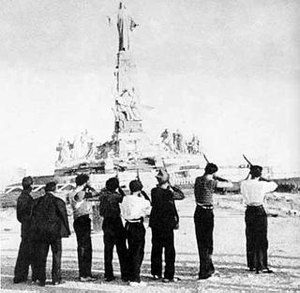
In Ireland, the war was largely presented as a fight to preserve the Catholic religion in Spain from the ‘Reds’ or communists. Eoin O’Duffy, who led the Irish volunteers for Franco stated “It is not a conflict between fascism and anti-fascism but between Christ and anti-christ,”.[3].
Though this was a huge oversimplification of a very complex conflict, it had great resonance in Ireland among pious Catholics and was enthusiastically preached by the Catholic clergy.
The anti-clerical nature of the Republican side and the atrocities they committed against the Catholic clergy were exaggerated in Ireland, but they were not an invention. It is estimated that about 7,000 priests and nuns were killed by Republican forces, or their supporters, mostly during the early months of the war.[4]
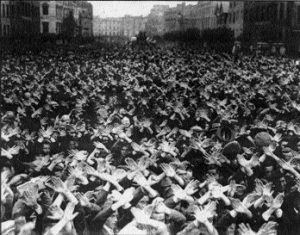
While there were some avowed fascist sympathisers among O’Duffy’s men, the view that they were defending the Catholic Church from a tyrannical left wing government was far more common among them.
Maurice Fennell of Rathkeale County Limerick, one of O’Duffy’s volunteers, later wrote that ‘the Republican ideal was betrayed by the Republicans themselves’, who oversaw ‘lawlessness, never-ending strikes, persecution of the Church and the breakdown of the administration’.[5]
It must also be appreciated that Catholic anti-communism was a serious force in Irish politics in the 1930s. When, for instance, in 1932, a Communist Party, the Revolutionary Workers Group attempted to set up branches around the country, they were effectively hounded out of existence after denouncement by the Catholic Church. In County Kilkenny for example where communist activists tried to set up a miners’ union in the coal fields at Castlecomer, the Bishop of Ossory thundered,
‘I authoritatively say, no Catholic can be a communist, no communist can be a Catholic’… we warn all obstinate leaders or agents of communism in this diocese that we will fight for our faith with all the tenacity and courage of our forefathers…And we will win. God is on our side. It is God’s battle.’[6]
In 1936 the Irish clergy and groups such as the Irish Christian Front staged rallies all over the country in support of Franco. Against this background it is not surprising that many young men saw ‘God’s battle’ against communism as a cause to be taken up in Spain.
Eoin O’Duffy and the formation of the Irish Brigade
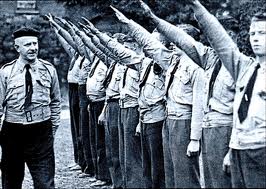
Leading the Irish volunteers to their ‘crusade’ in Spain was Eoin O’Duffy, a man who already had a long history in Irish politics.
O’Duffy had served as an IRA commander in Monaghan during the Irish War of Independence and grew to be a close ally of Michael Collins.
When the IRA split over the Anglo-Irish Treaty in 1922, he took the pro-Treaty side and in the ensuing Irish Civil War, served as a Free State army general and then Garda (police) Commissioner until 1933. In that year he was sacked by Eamon de Valera, when his anti-Treaty Fianna Fail party came to power.
Through his years as chief of police, O’Duffy had grown increasingly skeptical of parliamentary democracy and even tried to interest elements in the Garda and Army in a coup to stop de Valera and Fianna Fail from taking power after their victory in the 1932 election.[7]
Eoin O’Duffy was a marginalised figure by 1936 and saw the war in Spain as a way to reassert himself in Irish politics.
In the years that followed O’Duffy was the leader of the Blueshirt movement, a semi-fascist movement of pro-Treaty Civil War veterans who were hostile to Fianna Fail, the IRA and to communism and who appeared for a time to threaten Irish democracy itself.
O’Duffy was briefly the leader of the main opposition party, Fine Gael in 1933-34, but after less than a year he was forced out for his extreme views. He even lost control of the Blueshirts to his rival Ned Cronin and went on to found his own ‘Greenshirts’ and National Corporatist Party, who were far more openly fascist than the Blueshirts.
O’Duffy was thus a marginalised figure by 1936 and looking for a way to again boost his public image. For a brief time, after the outbreak of the Civil War in Spain, his implacable anti-communism and sympathy for fascism chimed with the public mood.
In August of 1936, O’Duffy suggested the formation of an Irish brigade to fight in Spain and sent to the press statements, “condemning the anti-God campaign of the Spanish Government and calling on our Government to break off diplomatic relations with Spain”.[8]
When Franco’s ally Count Ramirez de Arellano appealed to the Irish Catholic clergy, specifically Cardinal McRory, for Irish volunteers to fight on their side in Spain, the cardinal reached out to O’Duffy. In September 1936, O’Duffy met Arellano, and two Francoists, an engineer Juan de la Cierva and general Emilio Mola, in London and promised to recruit an Irish contingent to fight in the Civil War.[9]
O’Duffy appears to have promised them a large contingent led by professional Irish Army officers. The reality, however was to be very different.
Recruitment
O’Duffy claimed at one point to have 7,000 volunteers, but ultimately only 700 went to Spain.
He seems to have had a commitment at some stage from Hugo MacNeill, the Adjutant General of the Irish Army, who like O’Duffy was a pro-Treaty veteran of the Irish Civil War, to command his force. MacNeill however, perhaps wisely, backed out of the venture. But several other former National Army officers, Patrick Dalton, Colonel Tom Carew and Eamon Horan did go with the Brigade to Spain. Most of the officers were either members of O’Duffy’s NCP party or former Blueshirts. [10]
Most of O’Duffy’s volunteers believed they were fighting against the communist persecution of Catholicism.
The rank and file also included a significant number of National Army and pro-Treaty IRA veterans. Maurice Fennell recalled that the volunteers included Padraig Quinn of the ‘Old IRA’ and National Army, Sean Cunningham of the ‘East Belfast IRA’ and Tom Hyde and Tom O’Riordan ‘of the 1st Cork Brigade of the Old IRA’.[11] Anti-Treaty IRA figures, let alone left wing Republicans of the 1930s, when the IRA was influenced by socialist ideas, were, however, conspicuous by their absence.
Many of the recruits were young, with no military experience and most seem to have been recruited on the basis of Catholic anti-communism. For instance eight men from Enniskillen in County Fermanagh were recruited by a local priest, Father Cathal O’Daly.[12]
Others, though as even one sympathetic priest remarked, would ‘in the old days take the English bob and join the British Army’ and others simply wanted a change from ‘standing at the corner and staring at the pump’.[13]
Many appear to have been rather naive. Mrs Rogers, for instance of Drumcondra, Dublin wrote to the Irish government trying to secure the repatriation from Spain of her son Joe, who thought he was part of an ‘Irish crusade against communism’ but who was really ‘still only a lad’. Other worried parents in Tralee thought their son, John O’Conor aged 17 was ‘not of the age or physical training to be a soldier’ and was going to ‘certain death’ in Spain.
Another volunteer wrote to his mother from Spain that, ‘I didn’t want to tell you I was coming here as I was afraid you wouldn’t like it… please forgive me because I treated you rotten…but after all what I have done is for Our Lord’.[14]
Around 200 volunteers left Ireland for Spain in secret while 500 more left after a public rally in Eyre Square in Galway on 13 December 1936. One of O’Duffy’s officers, Liam Walsh had flown to Berlin and convinced the Nazi government to supply a ship that would ferry the Irish volunteers to Spain.[15]
At Galway they were loaded onto a ship named the Dun Aengus and steamed out into Galway Bay, where they were picked up by a German ship, the SS Urrundi flying the Nazi swastika, which brought them to Spain.
According to T Ryle Dwyer, another 700 men were waiting at Passage East, County Waterford to be shipped to Spain but the ship to carry them never appeared.
Irish government response
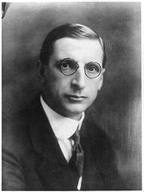
O’Duffy boasted that “The Irish brigade will eventually be 10,000 strong.” This like many of O’Duffy’s pronouncements, was a vainglorious invention, but more men might have gone to the war, had not, in February of the following year, the de Valera government passed laws prohibiting any more Irishmen to go to Spain to fight for either side.
Contrary to stereotypes about ‘De Valera’s Ireland’ slavishly following the dictats of the Catholic Church, the De Valera government and civil service appear to have been most uncomfortable with the church’s militant position on Spain.
The Department of Justice was caught by surprise when the large Irish contingent set out for Spain from Galway. The secretary reported to the department of External Affairs;
“We do not know whether the police had in fact any advance information in regard to the proposal to embark at Galway and simply did not think it worthwhile to report it in the absence of any clear indication that the proposed expedition was illegal or unwelcome to the Government, or whether the police were in fact altogether taken by surprise,”.
“The Attorney General has advised that no offence is committed by persons joining or encouraging others to take part on the side of the insurgents in Spain and it would seem that persons are equally free to join the Government forces,” the secretary added. [16]
Throughout late 1936 they looked for a way to stop Irish volunteers from going to Spain to fight.
The de Valera government in February 1937 made it illegal for any more Irish men to travel there to fight for either side.
The British government outlawed participation in the Civil War in January 1937 with the Foreign Enlistments Act. The de Valera government followed suit in February 1937 and made it illegal for any more Irish men to travel there to fight for either side.
The Department of External Affairs had this to say about O’Duffy’s Volunteers;
‘The general character of volunteers who have already gone to Spain does not appear to be very high, but we have information that some of them are very young men who have been enticed from their families through the impression that they are going to fight for Christianity’.
They added that the pro-Franco position of the papacy and the Irish clergy was ‘not very helpful guidance’, and also worried about the effect of ‘the return from a foreign war of this terrible character of men whose outlook cannot but be altered for the worse’. [17]
The official position of the Irish government on the Spanish war was neutrality. Ireland formally signed up to the international non-intervention agreement regarding the Spanish Civil War on February 26 1937, committing to prevent the export from Ireland of ‘articles which are implements of war or war material’. Ireland contributed a small sum of £8,000 towards this goal. The total contributed by foreign powers was over £1 million, mostly donated by France and Britain. [18]
The non-intervention pact in the end benefited the Francoist side more, as it prevented the Republic from buying arms from the democratic powers, Britain and France, while Italy and Germany brazenly ignored the pact, (although Germany was a signatory) and openly intervened militarily in Spain.
In Spain, at Caceres
In Spain, O’Duffy’s Irish Volunteers embarked at the town of Ferrol in Corruna province, Galicia, and were taken to the town of Caceres, near the Spanish-Portuguese border to receive equipment and training.
The Irish press published letters sent home from the front including one from Charles Campling of Fermanagh, who wrote that ‘the Spanish people are very kind to the volunteers. “We marched to Mass on Christmas Day, and heard three Masses”. “The celebrant was an Irish priest and very nice. We had a very pleasant Christmas’.[19]
A television documentary made by Cathal O’Shannon for RTE in 1976 named ‘Even the Olives Are Bleeding’[20], includes interviews with locals at Caceres saying that the Irish were very ill-disciplined and often drunk and disorderly. O’Duffy himself seems to have acted more as a tourist than a military commander in Spain and did little to prepare his men for combat.
The Irish witnessed mass executions of captured Republicans at Caceres.
But already, even in the training camp at Caceres, the Irish Brigade was exposed to the savagery of the Spanish Civil War. One volunteer, Seamus MacKee said that at night they heard the sound of volleys from the prisoner camp next door, ‘we presumed these were firing squads which were busy shooting people who did not appreciate the benefits of Franco’s rule’.[21]
Maurice Fennell left an even more explicit account. He went to see one of the mass executions;
‘It was here that Red troops who were tried and found guilty of certain crimes were executed. It was not a nice sight. I went to see it once and that was enough. That morning there were twelve for the firing squad. I was amazed that almost all of them fell forward. One little fellow of about five foot three, at the end of the line ,after falling, tried to get back up. He got to his knees and gave the communist clenched first salute and then took another burst of machine gun fire before he died.
Fennell tried to comfort himself with the thought that the executed men were war criminals:
Later I learned that they were a group of Russian soldiers who were captured tried and found guilty of fiendish atrocities against the civilian population, mainly doctors Priests and Nuns.’[22]
No doubt this is what Fennel was told, but in truth it is extremely unlikely. The men who he saw executed may or may not have themselves committed atrocities, but there were no Soviet combat troops in Spain at the time, only some advisors, well behind front lines. The unfortunate men were probably Spanish Republican soldiers who were captured and shot out of hand. It is also very unlikely that they got a trial of any kind.
Fennell was disturbed by the executions, as most Irish volunteers seem to have been, writing; ‘I prayed I would never be placed in the position of those soldiers who made up the firing squad’. But he still steeled himself to take part if so ordered: ‘If however I was detailed for such a task, I knew I would do it. Not because I liked but because it was my duty to the cause’.[23]
Fennell’s account of mass executions at Caceres is confirmed by a Kerry volunteer who later spoke to the press in Ireland in June 1937.
‘We saw General Franco’s army executing Reds each morning in massed groups. They machine gunned the condemned people, beginning at their ankles and directing the fire the fire up their bodies. The Reds in their last moments lifted their clenched first in the communist salute and shouted ‘Viva Madrid’. [24]
In Caceres town alone, modern counts have confirmed at least 677 victims of the ‘Francoist repression’ – that is killed or otherwise died in captivity – with another 1,000 deaths in its rural hinterland.
Friendly fire
On February 16, 1937, after about six weeks of training at Caceres, O’Duffy’s Irish Brigade were sent to the front at the town of Ciempozuelos about 35 km south of Madrid. They de-trained at Valdemoro and marched on foot towards the front lines at Ciempozuelos.
On February 19, they were just outside the town on a sunken road when they came under fire for the first time. The Irish returned fire and for about an hour a stiff gun battle was joined. It was only after the firing had died down that they realised they been engaged by their own side. The gun battle was an exchange of ‘friendly fire’ with Francoist troops in which a number of casualties were inflicted on both sides.
According to one Irishman, Matt Becket, ‘We were attacked by a Brigade from the Canary Islands who mistook us for Reds’. It seems that the Irish were confused by Spanish Nationalist unit from the Canary Islands for the enemy (which had foreign volunteers in greater numbers) and opened fire on. In an hour’s fire fight with their own side two Irishmen and up to nine Spaniards were killed.[25]
It was an inauspicious start to their war.
The Battle of Jarama and the front at Ciempozuelos
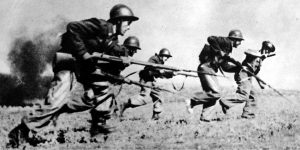
The Irish had arrived at the front towards the tail end of the Battle of Jarama, a massive offensive in which Nationalist forces attempted to cut the road between Republican-held Madrid and Valencia, where the Republican government had relocated after the war had started.
The battle raged from February 6 to 27, 1937, the first phase being the Nationalist offensive across the river Jarama and the second a Republican counter offensive, which ultimately pushed them back and prevented the cutting of the Madrid-Valencia highway. Among the Republican forces were left wing volunteers of the International Brigades, including an Irish contingent led by Frank Ryan.
The Bandera was stationed at the town of Ciempozuelos during the battle of Jarama in 1937.
The town of Ciempozuelos itself was attacked by the Nationalist troops, primarily Moroccans (known at the time in Spain as ‘Moors’) of the Army of Africa on February 6 1937 and after five days of fierce fighting, it fell on February 11. The inexperienced Republican garrison, the 18th Mixed Brigade, were at a decided disadvantage, never having been in combat before and some not even having the correct ammunition for their weapons. They were all but annihilated, losing up to 1,300 dead.[26]
The Irish Brigade, fresh from their lethal encounter with their own side arrived in Ciempozuelos not long after its capture by the Moroccans, and were placed in a trench line near the town. They were horrified by the remnants of the battle.
According to Seamus MacKee,
‘At Ciempozuelos we found traces of a recent desperate battle. Moors occupied the town. Dead bodies were scattered all over, houses were wrecked and we got our first taste of the horrors of war. We took over from the Moors and the next day, they withdrew from the town.’[27]
Similarly, Maurice Fennell found himself in a shell hole with corpses:
‘A new and sickening sensation gripped me, it was the stench of rotting flesh. I opened my eyes and there were three dead and decaying bodies only inches away and seemingly looking straight at me’… ‘I thought it was a nightmare’.[28]
The Church at Ciempozuelos was wrecked by the anti-clerical Republicans while they occupied the town, an act which shocked the pious Irish volunteers. One Paddy Hickey, wrote back to his mother from the front on 6 March 1937 that the ‘the reds smashed up the chapel’ at Ciempozulos ‘the rotten cowards’.[29]
Maurice Fennell related even more lurid, though second hand, stories of ‘Red’ atrocities.
‘Ciempozuelos was of course completely deserted by its civilian population who had fled before the Red forces to the hills and the caves… The daughter of local doctor told us that her father had been cruelly and inhumanly tortured and before he died they pulled off his finger nails with a pliers and still bleeding they caught him by the wrist and made him write ‘VIVA RUSSIA’ on the wall with his own blood’. This was plain to be seen [on the wall].’
Fennel heard that the ‘infants were nailed to the doors, to die a lingering death’ and that the older Nun watched ‘while the younger nuns were stripped and raped publicly in the streets’. The Church and religious statues were all destroyed and desecrated. According to Fennell, ‘The desecration was almost unbelievable. The perpetrators must have been insane or demonical’.[30]
Apart from the material destruction to the Churches, Fennel did not see the deeds related above, nor do the other contemporary letters mention the more lurid scenes, of torture and rape. Nor did Fennell speak Spanish, so he had no way of assessing the testimony he was hearing, but we should respect that this was what the Irish volunteers believed that they were fighting against.
According to historian Fearghal McGarry, however, it was in fact the Moroccan Francoist troops who had massacred the town’s garrison and those civilians who had not fled their advance, ‘the whole town was covered in blood and bodies were to be seen piled in the cellars’. The Irish volunteers had to bury hundreds of corpses in the town.[31]
Discontent and disbandment
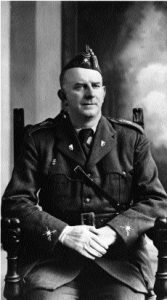
The conditions in the trenches at Ciempozuelos were harsh, food was bad and the Irish Brigade were under regular artillery and mortar fire.
Discontented volunteers later told the Irish media that their diet was one of hard bread and black coffee and that ‘we never saw the Reds, but were often under Red artillery fire’.[32]
According to some stories, the Irish volunteers on the Republican side were stationed in the trenches opposite them and appealed to the pro-Franco volunteers to go home and stop ‘fighting for imperialism’.[33] This may be apocryphal, but it is certainly true that the Irish Republican volunteers under Frank Ryan were stationed just across the Jarama valley at the time, at the villages of Chincon and Morata.
Morale had been deteriorating for some time among the Irish Brigade, but the final straw came when they were ordered to attack a fortified village named Titulcia on the other side of the Jarama valley. When they moved into the assault, they were hit by artillery fire and several men were killed. After this the Irish retired to their own lines and refused orders to resume the attack.
When ordered to make a frontal assault on Republican positions, the Irish took some losses and refused to renew the attack.
In a war characterised by very costly frontal assaults, this was an extraordinary act of disobedience by the Irish contingent. It would have been unheard of for a unit of the Spanish Foreign Legion or Army of Africa, to which the Irish were attached, to have openly disobeyed orders to attack, as the Irish had done at Titulcia, after what were, by Spanish Civil War standards, fairly light casualties. According to Tom Hayes’ diary, six men were killed and 15 wounded in the attack on Titulcia. [34]
By way of comparison, earlier in the battle of Jarama, the Republican Abraham Lincoln International Brigade, a unit 450 strong, mainly of American volunteers, including an Irish section nicknamed the ‘Connolly column’, took 120 killed and 175 wounded, or nearly two thirds casualties, in a futile attack on Nationalist positions at Pingarron.[35]
The Irish bandera appear to have had less commitment and less tolerance for heavy losses. After the debacle at Titulcia, the Irish Brigade were transferred to a quieter sector at the village of La Maranosa.[36] At Maranosa, in their one successful action, the Brigade captured a Republican armoured train and took the crew prisoners. According to Seamus MacKee, ‘a Moorish detachment got a hold of the prisoners and shot them down like dogs. This sent a shock of horror through the whole Irish bandera. Only a handful expressed any desire to remain.’ [37]
The Spanish Francoist commanders were increasingly dissatisfied with their performance and many blamed O’Duffy, who was not present at the front, for his failure to prepare and to lead the Irish contingent.
Leo Kerney, the Irish ambassador to Spain, reported;
“They [the Francoists] thought originally that O’Duffy had the military experience and science of a general; they now know from conversations with him and otherwise, that his military knowledge is very limited,” Kerney added. “O’Duffy seems to have completely lost credit with Franco.”
Colonel Yague wrote to Franco in 1937 that ‘the military efficiency of this unit is absolutely nil’ and recommended they be sent home.
Garda Inspector Michael Mansfield thought that; “This was chiefly due to O’Duffy’s selection of officers to lead the Brigade in Spain. It appears that the selection was not made on a basis of ability as soldiers, but as politicians to act in his interests when the Brigade returned to Ireland.”[38]
On March 24, 1937, Colonel Juan Yague, who commanded Franco’s forces on the Madrid front wrote to Franco himself, castigating the leadership and administration of the Brigade and recommending that they be sent home.
The total lack of professional commanders of the Irish Brigade bring the following consequences: Discipline is still very deficient in its period of inspection as had been related and on coming to the front insolence and disobedience is rife, and there have been reports of aggressions by soldiers to officers… The military efficiency of this unit is absolutely nil. For all of these reasons I consider it a danger (for its [bad] example and because the stretch of front they occupy in attack or defence will never be safe) that this brigade continues to be organised and I think it would be convenient to dissolve it and distribute it among the other brigades, for those who want to stay and … for the rest repatriate them. [39]
In April 1937, the Irish unit was disarmed after one of their officers, Dermot Sullivan, threatened, after an argument with Spanish officers, to change sides and go over to the Republicans. This was probably due more to petulance than conviction on Sullivan’s part, but as Fearghal McGarry remarks, ‘officers had been shot for much less’ in the Spanish Foreign Legion.[40]
Franco seems to have concluded at this point that the Irish were of little use and acceded to a request by O’Duffy that they be shipped back home to Ireland. The future dictator of Spain by this time appears to have formed the view that O’Duffy was merely using the war in Spain to boost his image in Ireland and in their last meeting told him ‘he must either do what he was told or clear out’.
In the meantime the Irish Brigade were sent back to Caceres, where they witnessed yet more executions of captured Republicans. Tom Hayes recorded seeing the executions of 15 ‘Reds’ ‘shot behind the barracks there on May 25, 1937’.[41]
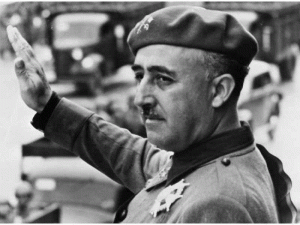
By this stage a great deal of disillusionment had set in among the Brigade’s volunteers. Paddy Hickey wrote to his mother, 26 April 1937, saying, ‘we are all fed up’ and glad to be going home. [42]
Another volunteer, Matt Becket, recalled ‘The lads were anxious to go home. The only men who stayed behind were Tom Jones, ex RUC Belfast, and Davy O’Dea of Offaly.’[43]
Tom Hayes wrote that the total Brigade losses were 35 dead, 40 wounded, and ‘more died after returning home’.[44] Sam McGrath has calculated that ten of the Irish Brigade were killed in action but that up to 21 more may have died of wounds or disease.
By 1939, the last year of the war, the Department of Foreign Affairs knew of only one member of O’Duffy’s Brigade still in Spain; Andrew O’Toole, who had deserted the British Army to go to Spain and subsequently, when the rest of O’Duffy’s men left, had joined the Spanish Foreign Legion. After ‘prolonged correspondence’ between the Irish government and the Franco authorities, they agreed to discharge him and send him back to Ireland as he had been a minor when he enlisted.[45]
Back Home
The main contingent of O’Duffy’s men arrived back in Dublin on 21 June 1937. While O’Duffy hoped for a triumphal procession back through Dublin, his men ‘tramped in silence’ through the streets of Dublin. Some onlookers heckled the Brigade with shouts of ‘Up the Republic’, although Dublin’s Lord Mayor Alfie Byrne did host a reception for O’Duffy and his men.
Significantly, the Northern men and the Kerry contingent split off from the rest of the Brigade when they were marching through Dublin and made their own way home – a clear sign of disillusionment with the affair. [46]
By mid 1937, enthusiasm for Franco in Ireland had cooled.
By this time, the initial enthusiasm in Ireland for Franco’s cause had cooled significantly. Demonstrations in favour of Franco had by and large ceased with the realisation that the war in Spain was not a simple matter of Catholicism against communism.
The bombing of the Basque town of Guernica, by German aircraft, for instance in April 1937, according to the Irish Times ‘horrified the world’, especially as it was a civilian target, ‘hallowed by a thousand years of national and religious memories’. Such atrocities, made it, the Times editorialised, ‘exceedingly difficult to maintain that General Franco is fighting a Holy War’.[47]
The Times expressed its relief at the return of O’Duffy’s men and at the news that their casualties had ‘not been very heavy’.
Assessments
Assessments of the expedition have generally been negative. Some scornfully note that the Brigade did more damage to their own side than to the enemy. Others excoriate the Brigade for fighting on the side of fascism against the Spanish Republic. While there are numerous memorials in Ireland to the Irishmen who fought for the International Brigades, there is only one small plaque in Dublin’s pro-Cathedral to one of O’Duffy’s men, as well as a monument in Spain erected by the Francoist authorities in Caceres.
Some volunteers like Seamus MacKee regretted going to Spain, ‘and fighting on behalf of a bad cause.’[48] Many other veterans of the Brigade kept quiet about it in later years. But some of the Brigade’s volunteers were unrepentant. Matt Becket, later wrote, that ‘fascism may not have been such an evil thing’ and that their cause was ‘better than the International Brigades’. He argued that at the time the Irish people supported the cause of Franco against the ‘Red Government’ in Spain, whereas by the time he was writing (1989) it was the left wing volunteers who were feted as heroes. He felt vindicated by the ultimate collapse of communism in that year. [49]
Similarly, Maurice Fennell reiterated in his memoir that he had volunteered ‘to fight for Christianity and Spain’ and to repay the historic debt they owed for Spanish aid to Irish in the past. [50]
Some volunteers regretted their actions but others were unrepentant abotu the ‘Crusade in Spain’.
Even among some of the Kerry contingent, who broke with O’Duffy, there was repudiation of the conduct of the ‘Crusade’ but not of the cause itself.
Eamon Horan of Tralee stated on his return that ‘we have returned from a campaign that should have added one of the most glorious chapters to the pages of Irish history; but instead of returning with honour and renown, we return humiliated and disgraced’. The Kerrymen had, he told the press, gone to Spain to fight for Christianity against ‘the devilish agents of Moscow’ but had found it was ‘a political campaign’ and had ‘now broken with O’Duffy’.[51]
As for O’Duffy himself there has been no rehabilitation of his reputation. During the Second World War he again made contact with the forces of the far right, in the person of German agent to Ireland Herman Goertz, who tried to use him in infiltrate the officer corps of the Irish Army.[52] O’Duffy by this time had developed a serious alcohol problem and his health deteriorated rapidly.
He died in 1944.
See also our podcast on this topic here.
References
[*] Franco, the commander of the army of Africa was not the initial commander of the coup, but he had assumed supreme command of the Nationalist or right wing side by the end of 1936.
[1] Seamus MacKee, ‘I was A Franco Soldier’, written in 1938, published in the Irish Times, July 17, 1986.
[2] For a summary see Fearghal McGarry History Ireland and the Spanish Civil War https://www.historyireland.com/20th-century-contemporary-history/ireland-and-the-spanish-civil-war/
[3] T Ryle Dwyer Irish Examiner 2012 November 31
[4] http://news.bbc.co.uk/2/hi/europe/7066094.stm
[5] Maurice Fennell unpublished memoir Stradling Papers, University of Limerick P13/45 10
[6] Kilkenny Journal January 7, 1933
[7] Fearghal McGarry, Eoin O’Duffy, A Self Made Hero, p.191-192
[8] T Ryle Dwyer Irish Examiner 2012 November 31
[9] Fearghal McGarry, Irish Politics and the Spanish Civil War, p.27
[10] Fearghal McGarry, Eoin O’Duffy, A Self Made Hero, p.289
[11] Maurice Fennell unpublished memoir Stradling Papers, University of Limerick P13/45 10
[12] Ulstermen and the Spanish Civil War by Ciaran Crossey in “Due North”“Due North” is the journal of the Federation for Ulster Local Studies.This article appeared in Vol. 1, Issue 5, Spring-Summer 2002
[13] McGarry, Eoin O’Duffy, p.290
[14] NAI Department of Foreign Affairs 241/12
[15] McGarry, Eoin O’Duffy, p.291
[16] T Ryle Dwyer Irish Examiner 2012 November 31
[17] National Archives of Ireland (NAI), Department of Foreign Affairs, DFA/241/12, memo on O’Duffy’s Brigade, 18 December 1936
[18] NAI Department of Foreign Affairs227/17
[19] Irish Press, 11th January 1937 p.7
[20] Even the Olives ae Bleeding can be viewed here on vimeo
[21] Seamus McGee, I was a Franco Soldier, published July 17, 1986 Irish Times.
[22] Maurice Fennell unpublished memoir Stradling Papers, University of Limerick P13/45 10
[23] Maurice Fennell memoir, Robert Stradling Papers, University of Limerick, P13/45 10
[24] Irish Times June 26, 1937, p15
[25] Stradling papers, P13/29
[26] According to this website
[27] Seamus Mc/kee, I was a Franco Soldier, published July 17, 1986 Irish Times).
[28] Maurice Fennell memoir, Robert Stradling Papers, University of Limerick, P13/45 10
[29] Stradling papers P13/4
[30] Fennell memoir, Stradling Papers, P13/45
[31] Fearghal McGarry, Eoin O’Duffy a Self Made Hero, p. 303
[32] Irish Times 26 June 1937 p.15
[33] McGarry, Eoin Duffy, p. 304.
[34] Stradling papers P13/10 page 14
[35] Hugh Thomas the Spanish Civil War, p.491
[36] McGarry, O’Duffy, p. 306
[37] Irish Times, I was a Franco Soldier, 17 July, 1986.
[38] T Ryle Dwyer Irish Examiner 2012 November 31
[39] Stradling papers P13/6
[40] McGarry Eoin O’Duffy, p. 313
[41] For Franco’s view of O’Duffy, McGarry, Eoin O’Duffy, p.314 For executions at Caceres, Hayes diary Stradling papers P13/10.
[42] (Stradling P13/8).
[43] Becket Memoir, Stradling papers P29/13
[44] P13/10 Stradling papers, Tom Hayes Diary.
[45] NAI DFF 241/12
[46] McGarry, O’Duffy, p.317
[47] Irish Times, May 3, 1937
[48] MacKee, I was a Franco Soldier’.
[49] Becket, Stradling Papers UL P13/29.
[50] Fennell, Stradling papers UL P13/45
[51] Irish Times 26 June 1937 p.15
[52] McGarry, Eoin O’Duffy, p.336